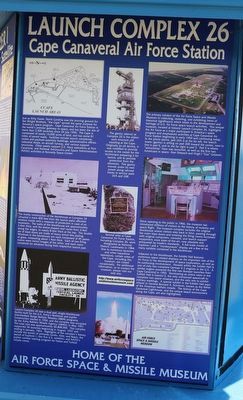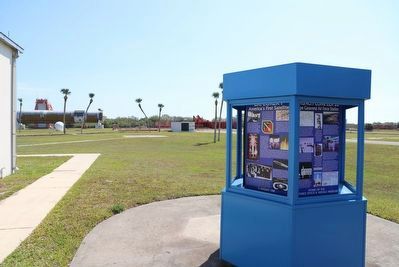Cape Canaveral in Brevard County, Florida — The American South (South Atlantic)
Launch Complex 26
Cape Canaveral Air Force Station
— Home of the Air Force Space & Missile Museum —
Just as Kitty Hawk, North Carolina was the proving ground for the Wright Brothers, “the Cape” served the same purpose for America’s space program. Cape Canaveral Air Force Station is the world’s premier gateway to space, and has been the site of more than 3,300 launches since 24 July 1950. The Cape is composed of nearly 16,000 acres of land, and has some 81 miles of paved roads. Facilities include launch complexes, rocket and payload assembly buildings, administrative offices, industrial shops, an aircraft runway, and various support structures. Other assets support U.S. Navy operations at Port Canaveral, and National Aeronautics and Space Administration (NASA) activities at Kennedy Space Center.
The gantry (above) at Complex 26 is the oldest such structure still standing at the Cape. Originally an oil derrick, it was modified to provide access to the rocket for the technicians preparing it for launch, and to provide protection from the elements. This gantry moved under its own power along railroad tracks to service pads 26A and 26B.
The primary mission of the Air Force Space and Missile Museum is collecting, restoring, and exhibiting items of historical significance which relate to the development and heritage of U.S. Air Force space launch activities. This unique museum, located at historic Launch Complex 26, highlights the Air Force as a major participant in America’s space program and emphasizes activities at Cape Canaveral Air Force Station beginning in early 1950 and continuing today. In the photo above, pad 26A is at the far left, the launch tower (gantry) is sitting on pad 26B toward the center, next in line is pad 6, and to the far right is pad 5. Pad 5 is where “astrochimp” Ham was launched, as well as the first two Americans in space: Alan Shepard and Virgil I “Gus” Grissom.
The sturdy construction of the blockhouse at Complex 26 (situated a mere 400 feet from the launch pads) afforded workers inside with a measure of protection in case of an explosion. The walls of the blockhouse are approximately 2-feet thick, and the dome-shaped roof varies from 5-feet along the edges, to nearly 8-feet thick at the top. The double set of blast doors are made of heavy armor-like plating. Windows in the blockhouse are each composed of 45 panes of glass, measuring about 1-foot thick. Each of two firing rooms were mirror images of the other, and each room contained six windows facing their respective launch pad.
Several sites at Cape Canaveral Air Force Station, including Complex 26, were designated as National Historic Landmarks in 1984. Due to numerous launches and other hazardous operations, certain areas of the Cape, including this museum, are closed occasionally. For additional information, or to contact the museum, please visit our web site: http://www.airforcespaceandmisslemuseum.com
Since opening to the public in 1966, the museum has introduced millions of visitors to the history of rocketry and space flight. The museum complex includes the original blockhouse where visitors step back in time, passing through the outer blast doors and entering the firing rooms furnished with original computers, consoles, and launch support equipment; once state-of-the-art, now obsolete and antiquated by modern standards. A full-scale model of Explorer I and a “monkeynauts” display are a few of the many exhibits contained in the blockhouse.
Adjacent to the blockhouse, the Exhibit Hall features numerous space related displays on the important role of the Air Force in the development of space exploration, as well as its continuing involvement. Housed within the Exhibit Hall is one of only two complete German V-2 engines in the U.S. A similar engine powered the first two Bumper launches from Cape Canaveral in 1950. Dominating an entire room in the Exhibit Hall is Gemini II, the only unmanned spacecraft to complete two space missions, and the only one to exhibit military markings. A special exhibit in the Exhibit Hall pays tribute to General Bernard A. Schriever, known as the father of the American ballistic missile. The history of the Cape Canaveral Lighthouse, and the unique beach environment along the Cape, are also highlighted.
Launch Complex 26 was a dual pad, single-blockhouse facility built for the U.S. Army’s Redstone and Jupiter Intermediate Range Ballistic Missiles (IRBM) programs. Construction started in 1956, and the complex was occupied by the Army Ballistic Missile Agency (ABMA) in May 1957. The total cost was approximately $6,808,000. This complex supported 36 launches beginning in August, 1957 and ending in January, 1963. Highlights of the complex’s history include the launch of primate Gordo, Able, and Baker; the launch of Explorer I, (the first U.S. satellite); and NATO’s Jupiter combat training program for Italian and Turkish missile crews.
Erected by Cape Canaveral Space Force Museum.
Topics. This historical marker is listed in these topic lists: Air & Space • Exploration • Science & Medicine. A significant historical date for this entry is July 24, 1950.
Location. 28° 26.638′ N, 80° 34.326′ W. Marker is in Cape Canaveral, Florida, in Brevard County. Marker is on Museum Circle south of Lighthouse Road, on the left when traveling south. Touch for map. Marker is at or near this postal address: 191 Museum Cir, Cape Canaveral FL 32920, United States of America. Touch for directions.
Other nearby markers. At least 8 other markers are within walking distance of this marker. Explorer I (here, next to this marker); Juno II (here, next to this marker); Redstone (here, next to this marker); Jupiter (here, next to this marker); a different marker also named Launch Complex 26 (a few steps from this marker); a different marker also named Launch Complex 26 (within shouting distance of this marker); a different marker also named Launch Complex 26 (within shouting distance of this marker); First United States Space Launch (within shouting distance of this marker). Touch for a list and map of all markers in Cape Canaveral.
More about this marker. The website link listed on the marker has been replaced by the link shown below.
Also see . . . Cape Canaveral Space Force Museum. (Submitted on March 8, 2023.)
Credits. This page was last revised on March 8, 2023. It was originally submitted on March 8, 2023, by Dave W of Co, Colorado. This page has been viewed 128 times since then and 16 times this year. Photos: 1, 2. submitted on March 8, 2023, by Dave W of Co, Colorado. • Bernard Fisher was the editor who published this page.

